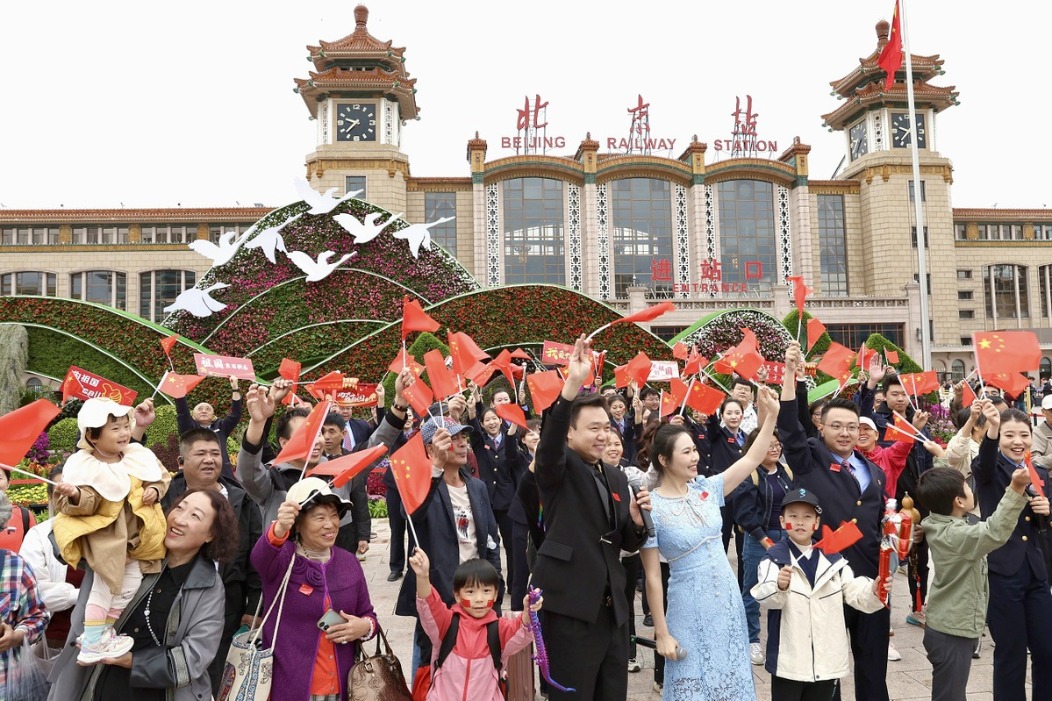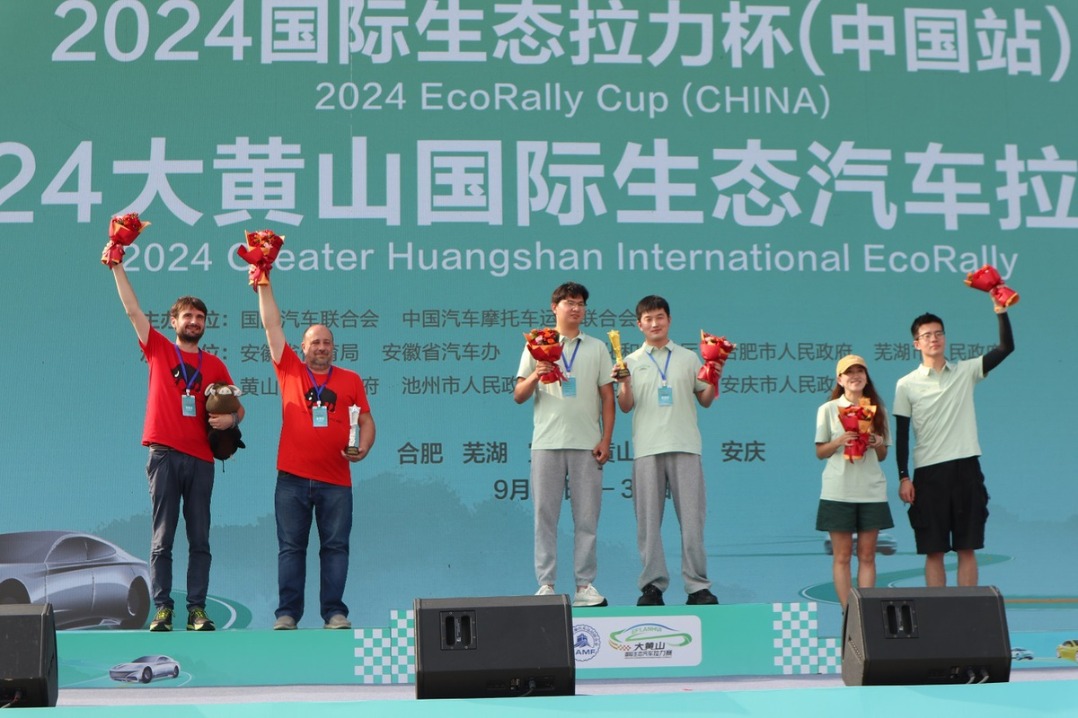HK airport: building a twin cargo base in GBA


The Sheng Ping 25 container vessel was standing by on a torrid afternoon at Humen Port, Dongguan, in Guangdong province, set to sail on a novel mission that is expected to have a significant impact on cargo traffic at Hong Kong International Airport. The vessel would take on airfreight collected from across the Guangdong-Hong Kong-Macao Greater Bay Area, and move to an intermodal cargo pier west of the airport.
The 11 cities of the Greater Bay Area, including the Hong Kong and Macao special administrative regions, handled more than 8 million metric tons of air cargo annually before the COVID-19 pandemic, with about three-quarters of the region's imported and exported airfreight going through HKIA. Most of the goods were transported to the airport by road, a route considered to be faster and more flexible. However, a new air-sea intermodal transshipment procedure has enabled the waterway to be used as an additional option for transporting merchandise from the Chinese mainland to the airport, further reducing the transportation time by road significantly.
The air-sea transshipment mode is the result of collaboration by authorities in the HKSAR and the city of Dongguan, which sits at the center of the Greater Bay Area and is known for its prominence as the "world's factory".
Behind the latest mode's success is a newly completed logistics park in Dongguan, equipped with facilities that enable mainland exports to complete customs clearance and security screening before arriving at HKIA.
The park, located in the Humen Comprehensive Bonded Zone, includes cargo terminals, public and self-operated freight houses, as well as security screening facilities.
It's the first time HKIA has allowed security checking procedures for air cargo to be conducted outside the SAR, says Cissy Chan Ching-sze, Airport Authority Hong Kong's commercial executive director.
Cargo security checks at the Dongguan park, supervised by AAHK, follow the same standards as those at HKIA, and the results are recognized by the HKSAR's Civil Aviation Department, Chan says. The security screening staff also works for HKIA's aviation security company and are from Hong Kong.
After completing customs clearance and security checks, the exports will go through the cargo acceptance procedures, in which cargo terminals will ensure that the goods are ready for aviation carriage in line with the regulations of HKIA and the airlines, as well as the import and export rules of countries and regions throuagh which the cargo will transit.
Depending on the size and categories of the goods, they will be locked in aircraft-size containers or fixed onto air cargo pallets. To ensure that cargo can fit in the holds of aircraft, this is normally done at the airport, but now it can be done at the Dongguan logistics park as well.
The processed cargo will be covered by plastic cloth and protection nets, and wrapped with tape to ensure it cannot be opened or damaged during transportation.
The exports will then be moved to Humen Port — a 15-minute drive from the park — and loaded onto freighters like the Sheng Ping 25 before being transported seamlessly to HKIA's west pier in the airport's restricted area. There are surveillance cameras on the vessels, allowing customs officers from the mainland and Hong Kong to monitor the cargo's passage.
Under normal circumstances, the freight arriving at HKIA via the "sea-air" transshipment mode won't have to be rechecked at the airport. This can save a few hours compared with road transportation, which has to undergo separate customs and security screening procedures at land crossings and the airport.
The mode works for both exports and imports, so goods arriving at HKIA can also be transported to the Dongguan logistics park along the same route. Currently, the mode is mainly used to transport outbound cargo.
At present, a ship departs daily from Humen Port for HKIA, carrying up to 100 tons of cargo on each trip.
According to Chan, the logistics park starts collecting and processing freight exports from about 6 pm each day. The cargo vessels leave at midnight and will anchor at HKIA early the next morning. This means that cargo arriving at the warehouses in the logistics park at 6 pm will be able to catch the flights departing at around 10 am the next morning. In road transportation, if the goods are prepared at 6 pm, they can normally be transported by aircraft leaving the following afternoon.
Unleashing potential
The novel transshipment mode began its trial operation in late 2021. Wha Hai Tech Logistics Supply Chain — a Hong Kong-based logistics company — was among the first batch of freight forwarders to move into the park.
Chris Cho Ho-sing, Wha Hai's general manager, tells China Daily that the sea-air mode has turned the Dongguan logistics park into an additional location for airfreight to complete the cargo acceptance procedures.
Since the park and HKIA can handle airfreight separately at the same time, more exports from the Greater Bay Area can be shipped via HKIA, boosting the airport's cargo throughput, he says.
Labor and storage costs in Dongguan are lower than those in Hong Kong, and this is a plus for forwarders who use the logistics park and the sea-air mode. Cho says the new mode allows cargo to be transported at night, enabling factories to manufacture products during the day. This arrangement will allow ships to carry as much cargo as possible on each trip.
Wha Hai is among four Hong Kong freight forwarders with their own warehouses at the logistics park. Cho says his company's warehouse is stacked with products from Dongguan and other cities in Guangdong. Some prominent mainland companies are also eager to join the project.
The park's trial operation went through ups and downs in the initial stages. But collective efforts have enabled the project to proceed smoothly. Cho recalls that initially, freight forwarders, cargo terminal and mainland officials, as well as AAHK representatives, often had to meet regularly to discuss how to fully leverage the sea-air mode's advantages. The decision to run cargo ships at night is one of the results of such collaboration, he says, adding that mainland customs officers also work at night to facilitate the operation.
The governments of the HKSAR and Dongguan formally launched the pilot program of the novel sea-air intermodal cargo transshipment project on Feb 16. Authorities from both sides also signed an agreement to deepen collaboration in the long run to facilitate cargo transportation in the Greater Bay Area.
Only a few companies had moved into the Dongguan park when it got off the ground. Today, there are about 27 freight forwarders at the park, and the number is expected to climb to about 40 in the next few months. All three cargo terminals at HKIA — Hong Kong Air Cargo Terminals, Asia Airfreight Terminal, and Cathay Cargo — are also operating at the park, providing cargo acceptance services to clients, including five airline companies.
The frequency of the freight ships traveling between Humen Port and HKIA is expected to be increased to two sailings daily within three months, Chan says. The program's short-term goal is to transport 150,000 tons of goods to HKIA annually.
Cathay Cargo says it has seen significant growth in tonnage handled at the logistics park since its maiden shipment from the park in March. It expects to see continued growth in freight handled, and will continue working with AAHK in the pilot project.
So far, the sea-air mode can be used by just a small number of enterprises as it's still in its infancy. But more Hong Kong companies have shown strong interest in the operation.
Yance Lin Huiyuan, a sales manager at Hong Kong-based KS Global Logistics, says his company mainly ships goods like electronic devices to Singapore, Australia and Dubai.
It would take an average of four to five days for a batch of cargo to complete road transportation, customs clearance, security checks and palletization before being loaded onto an aircraft.
It would be attractive to the company if the sea-air mode could reduce freight transportation time by more than a day on average, Lin suggests.
Strengthening collaboration
The Dongguan pilot program is just the beginning. According to the cooperation agreement, the HKSAR and the Dongguan authorities will try to find a seaward location in Dongguan to build a new permanent smart logistics park and a specialized port by 2025. A new airside intermodal cargo pier at HKIA's third runway will also be built at the same time to strengthen the mode's cargo handling capacity.
Once the two infrastructure projects are completed and the mode is in full swing, the entire project would be able to cut freight transportation costs by half on average and save one-third of the handling time. The long-term goal is to bring an additional 1 million tons of cargo to HKIA, equivalent to about a quarter of the airport's current annual cargo handling capacity.
After an inspection visit to the logistics park in April, Hong Kong lawmaker Gary Zhang Xinyu says if the new mode can help HKIA handle more than 1 million tons of cargo a year, it would be almost equivalent to "building a new Hong Kong airport outside Hong Kong".
Andrew Yuen Chi-lok, director of policy and knowledge transfer at the Chinese University of Hong Kong's Aviation Policy and Research Centre, calls the sea-air transshipment a win-win solution that shows how cities in the Greater Bay Area could complement each other.
Cities in the Greater Bay Area, such as Dongguan and Shenzhen, are world-class hubs for manufacturing electronic products and components. And Hong Kong's global aviation network is a vital part of the supply chain when it comes to transporting products around the world from the GBA.
"Cargo and travelers from other parts of the Greater Bay Area will be the key for Hong Kong in fully leveraging HKIA's third runway system and consolidating its position as a global aviation hub," Yuen says.
Besides the sea-air project in Dongguan, logistics experts and government officials are also trying to speed up the flow of goods from the west side of the Pearl River Estuary, which is linked to HKIA by the Hong Kong-Zhuhai-Macao Bridge.
Hong Kong Secretary for Transport and Logistics Lam Sai-hung led a delegation to Zhuhai earlier this year, and toured the Guangdong-Hong Kong-Macao Logistics Park now under construction.
The park is located at the conjunction of two highways from which cargo can be transported to Hong Kong via the Hong Kong-Zhuhai-Macao Bridge within an hour. The Zhuhai park's warehousing costs would be only about a fifth of those in Hong Kong.
Upon completion next year, the Zhuhai park aims to develop new intermodal cargo transshipment services involving aviation, waterways and railways based on its proximity to Zhuhai's Jinwan Airport, Zhuhai Port and the Zhuhai West railway station.
The local government also plans to turn the park into a global supply chain center to provide transit and warehousing services for airfreight, as well as financial and consultative services for freight owners and their agents.





































